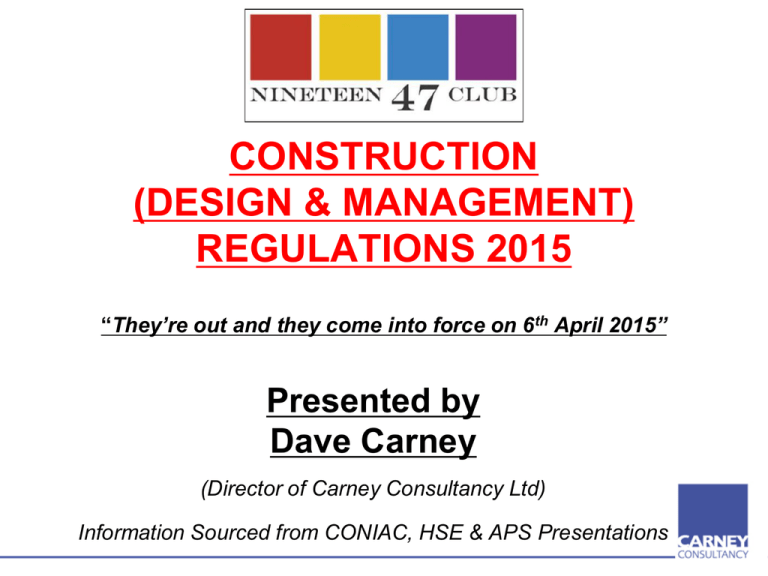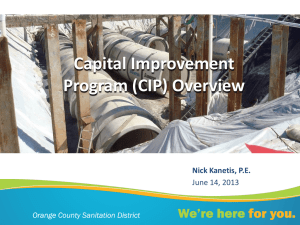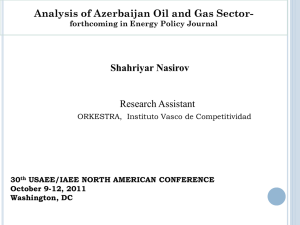Principal Contractors
advertisement

CONSTRUCTION (DESIGN & MANAGEMENT) REGULATIONS 2015 “They’re out and they come into force on 6th April 2015” Presented by Dave Carney (Director of Carney Consultancy Ltd) Information Sourced from CONIAC, HSE & APS Presentations What am I going to Cover? CDM2007 v. CDM2015 – the key changes Reasons for the HSE changing CDM2007 Domestic Clients The Principal Designer role – what will it involve? Implications for existing contracts Transitional arrangements The future for CDM Co-ordinators. The revised CDM Regulations were laid before Parliament on 29th January and are due to come into force on 6 April 2015. Reasons for the HSE changing CDM2007 CDM 2007 broad structure was fit for purpose: • Problems generally arose through misinterpretation of the Regulations • The Regulations had not borne down on bureaucracy as hoped • The Regulations had led to an industry approach to competence which was heavy-handed and in many cases burdensome, particularly on SMEs. Reasons for the HSE changing CDM2007 • The co-ordination function in the pre-construction phase was not in many cases well-embedded • Two thirds or more of fatalities now occur on small sites – sites where fewer than 15 people work • The larger, more structured part of the industry has made significant progress in improving its management of health and safety risks. Its motivation for achieving higher standards is often one of continuous improvement and innovation leading to best practice, rather than just meeting regulatory requirements. HSE Policy Objectives: • Maintain or improve worker protection; • Simplify the regulatory package; • Improve health and safety standards on small construction sites; • Implement the Temporary or Mobile Construction Sites Directive (TMCSD) in a proportionate way; • Discourage bureaucracy; and • Meet better regulation principles. Part 1 2 3 Structure of the New Regulations 4 5 Regulation 1 2 3 4 5 6 7 8 9 10 11 12 13 14 15 16 17 18 19 20 21 22 23 24 25 26 27 28 29 30 31 32 33 34 35 36 37 38 39 Detail Citation and commencement Interpretation Application in and outside Great Britain Client duties in relation to managing projects Appointment of the principal designer and the principal contractor Notification Application to domestic clients General duties Duties of designers Designs prepared or modified outside Great Britain Duties of a principal designer in relation to health and safety at the pre-construction phase Construction phase plan and health and safety file Duties of a principal contractor in relation to health and safety at the construction phase Principal contractor’s duties to consult and engage with workers Duties of contractors Application of Part 4 Safe places of construction work Good order and site security Stability of structures Demolition or dismantling Explosives Excavations Cofferdams and caissons Reports of inspections Energy distribution installations Prevention of drowning Traffic routes Vehicles Prevention of risk from fire, flooding or asphyxiation Emergency procedures Emergency routes and exits Fire detection and fire-fighting Fresh air Temperature and weather protection Lighting Enforcement in respect of fire Transitional and saving provisions Revocation and consequential amendments Review Part 1 2 3 Regulation Introduction Clients Duties H & S Duties and Roles Detail 1 Citation and commencement 2 Interpretation 3 Application in and outside Great Britain 4 Client duties in relation to managing projects 5 Appointment of the principal designer and the principal contractor 6 Notification 7 Application to domestic clients 8 General duties 9 Duties of designers 10 Designs prepared or modified outside Great Britain 11 Duties of a principal designer in relation to health and safety at the pre-construction phase 12 Construction phase plan and health and safety file 13 Duties of a principal contractor in relation to health and safety at the construction phase 14 Principal contractor’s duties to consult and engage with workers 15 Duties of contractors Part 4 5 Regulation General Requirements for all Construction Sites Transitional Provisions Detail 16 Application of Part 4 17 Safe places of construction work 18 Good order and site security 19 Stability of structures 20 Demolition or dismantling 21 Explosives 22 Excavations 23 Cofferdams and caissons 24 Reports of inspections 25 Energy distribution installations 26 Prevention of drowning 27 Traffic routes 28 Vehicles 29 Prevention of risk from fire, flooding or asphyxiation 30 Emergency procedures 31 Emergency routes and exits 32 Fire detection and fire-fighting 33 Fresh air 34 Temperature and weather protection 35 Lighting 36 Enforcement in respect of fire 37 Transitional and saving provisions 38 Revocation and consequential amendments 39 Review Application and Notification: • CDM2015 will apply to all construction work – no change here; • Pre-construction archaeological investigation is no longer construction; • Pre-construction information and the pre-construction phase are now clearly defined in draft regulations: – Pre-construction is any period when design or preparatory work is undertaken. Application and Notification: Any project, where it is reasonably foreseeable that there will be more than one contractor working on the site, will require the appointment both a Principal Designer (PD) and a Principal Contractor (PC) Application and Notification: Any project, where it is reasonably foreseeable that there will be more than one contractor working on the site, will require the appointment both a Principal Designer (PD) and a Principal Contractor (PC) A project is Notifiable whenever construction work is expected to: – last longer than 30 days and have more than 20 workers simultaneously at any point; or – exceed 500 person days. Domestic Clients: Definition of a client under CDM now includes domestic projects. • Where the client is a domestic client the clients duties must be carried out by: – The contractor where there is only one contractor; – The principal contractor for a project where there is more than one contractor; or – The principal designer where there is a written agreement that the PD will fulfil those duties. Domestic Clients: If no appointments are made by the domestic client: • The Designer in control of the pre-construction phase will be deemed to be the Principal Designer; • The Contractor in control of the construction phase will be deemed to be the Principal Contractor. Clients Generally Must: • make arrangements for managing a project that are suitable … to ensure that construction work is carried out (sfarp) without risk to the H&S of any person and Schedule 2 (Welfare) is complied with; • provide pre-construction information as soon as practicable to each designer and each contractor engaged by the client; • ensure that the arrangements are maintained and reviewed throughout the project. Clients Generally: A client must ensure that: • both the principal designer and the principal contractor comply with their duties; • before the construction phase begins the contractor (if only one) or principal contractor draws up a construction phase plan; and • the principal designer prepares an appropriate H&S File Client now responsible for notification of projects to the HSE as soon as is practicable before the construction phase begins. (F10 Form) General Duties - “Competence”: Appendix 4 competence criteria are removed. Reg 8(1) A designer (including a principal designer) or contractor (including a principal contractor) appointed to work on a project must have the skills, knowledge and experience and, if they are an organisation the organisational capability, necessary to fulfil the role that they are appointed to undertake, in a manner that secures the health and safety of any person affected by the project. Reg 8(2) A designer or contractor must not accept an appointment to a project unless they fulfil the conditions in 8(1) Reg 8(3) A person who is responsible for appointing a designer or contractor to carry out work on a construction project must take reasonable steps to satisfy themselves that the designer or contractor fulfils the conditions in 8(1). Reg 8(4) A person with a duty or function under these Regulations must cooperate with any person working on or in relation to a project, at the same or an adjoining construction site, to the extent necessary to enable the person with a duty or function to fulfil that duty or function. (Like CDM2007 Reg 5) Designers: Designers’ duties regarding elimination, reduction or control of risks has been more clearly spelt out: Reg 9(2) When preparing, or modifying a design the designer must take into account the GPP and any PCI to eliminate, sfarp, foreseeable risks to the health and safety of any person— – (a) carrying out or liable to be affected by construction work; – (b) maintaining or cleaning a structure; or – (c) using a structure designed as a workplace. Designers: Reg 9(3) If it is not possible to eliminate these risks, the designer must so far as is reasonably practicable— – (a) take steps to reduce, or if this is not possible, control the risks through the subsequent design process; – (b) provide information about those risks to the principal designer; and – (c) ensure appropriate information is included in the health and safety file. CDM Coordinators: • Will no longer exist as a statutory appointment from 6th October 2015; • Anticipated 6 month Transitional Period: • Any existing CDMC appointment will be allowed to run until October 2015 at the latest; Some of the CDMC’s role will be taken on by the new Principal Designer. Principal Contractors: Very little change here. Reg 12(1) During the pre-construction phase, and before setting up a construction site, the principal contractor must draw up a construction phase plan, or make arrangements for a construction phase plan to be drawn up. Reg 12(7) During the project, the PC must provide the PD with any information in their possession relevant to the H&S File, for inclusion in the H&S File. Principal Contractors: Reg 12(8) If the principal designer’s appointment concludes before the end of the project, the principal designer must pass the health and safety file to the principal contractor. Principal Contractors: Application of general principles of prevention: Reg 13(2) In fulfilling the duties in paragraph (1) and in particular when — • (a) decisions are made about the technical and organisational aspects of the project; and • (b) estimating the period of time required to complete the work or work stages; – the principal contractor must ensure that the general principles of prevention are taken into account. Management of Health & Safety at Work Regs 1999 General Principles of Prevention (Reg 4 Schedule 1) a) Avoid risk b) Evaluate the risks which cannot be avoided c) Combating the risk at source d) Adapting the work to the individual e) Adapting to technical progress f) Replacing the dangerous by non-dangerous or the less dangerous g) Developing a coherent overall prevention policy h) Giving collective protective measures priority over individual protective measures i) Giving appropriate instructions to employees. Contractors: Again, very little change here, but… • If there is no Principal Contractor, a construction phase plan is required – for every project; Reg 15(3)(a) Where there is more than one contractor working on a project, a contractor must comply with any directions given by the principal designer or the principal contractor; The Principal Designer role – what does it involve? Principal Designer means “…the designer in control of the pre-construction phase appointed under regulation 5(1)(a)…” Designer means “…any person who in the course or furtherance of a business – (a) prepares or modifies a design; or (b) arranges for or instructs any person under their control to do so,…” Responsible for planning, managing, monitoring and coordination of health and safety during preconstruction phase, taking into account the general ‘principles of prevention’. The Principal Designer role – what does it involve? PD must ensure: • project is carried out without risk to health or safety (sfarp); • assistance is provided to client in preparation of preconstruction information; • identification, elimination or control of foreseeable risks to h&s (sfarp); • cooperation of all; • designers comply with their duties; • prompt provision of pre-construction information to all designers and all contractors appointed by the client. The Principal Designer role – what does it involve? PD must: • Liaise with the principal contractor for duration of project; • Prepare a Health and Safety File during the preconstruction phase appropriate to the characteristics of the project… Removed from consultation draft: “which includes information from client re Control of Asbestos Regulations 2012.” The Principal Designer role – what does it involve? Who can do the role? Explicit requirement for competence has been removed from the CDM Regulations, however… PD must be a ‘designer’ in control of the pre-construction phase appointed by the client and capable of planning, managing, monitoring and coordinating the health and safety of the project during the pre-construction phase, taking into account the general principles of prevention. Transitional Provisions Reg 37 refers to Schedule 4: For projects involving more than one contractor which started before 6 April 2015, where by that date the client has not appointed a CDM co-ordinator, the client; a) must appoint a principal designer, as soon as practicable, if the construction phase has not started; b) is not required to appoint a principal designer if the construction phase has started, but may do so if they wish. If they choose not to appoint a principal designer, the principal contractor takes on the responsibility for the health and safety file (see Appendix 4). Transitional Provisions Schedule 4: Where on 6 April 2015 the client has appointed a CDM coordinator, they must appoint a principal designer within six months – i.e. by 6 October 2015. The CDM co-ordinator must then comply with the duties listed in paragraph 5 of Schedule 4 for the duration of their appointment. These duties broadly reflect duties of a CDM co-ordinator under CDM 2007, but also reflect the arrangements under CDM 2015 which relate to the construction phase plan and the health and safety file. Transitional Provisions Schedule 4: During the transitional period, CDM co-ordinators do not have to satisfy the criteria for a principal designer under regulation 5(1)(a) that they should be a designer with control over the pre-construction phase of the project, nor do they have to comply with the principal designer duties under regulation 11. Transitional Provisions Schedule 4 – other provisions: Any pre-construction information, construction phase plan or health and safety file provided in accordance with the requirements of CDM 2007 are recognised as meeting the requirements of the equivalent provisions in CDM 2015; Notification of a project in accordance with CDM 2007 is recognised as a notification for the purposes of CDM 2015; and A principal contractor appointed under CDM 2007 will be considered to be a principal contractor for the purposes of CDM 2015. Implications • The very short Transitional Period could cause contractual problems – particularly with Term Contract appointments; • Many more projects will require the appointment of a Principal Designer and Principal Contractor – Standard Contracts will require significant amendments; • Clients may find themselves without someone to adequately advise and assist them with their management arrangements; • Not as many projects will require Notification to the HSE. Implications • Competent designers will be expected to be capable of discharging the PD role on smaller projects if asked by the client; • People should only take on the PD role if they have the capability to do so or have someone capable to help them discharge the duties; • Larger or more complex projects may require the appointment of a construction health and safety (CDM) adviser to advise and assist the PD or client; • If you are appointed as Principal Designer, employing someone else to do the PD role on your behalf will not transfer the legal liability but may help you discharge the duties. Summary • Emphasis is on people taking responsibility for risk, not passing it on; • Designers appointed to undertake the PD role should consider using a specialist H&S consultant for more complex/larger projects; • PDs should ensure they use an adequate form of appointment; • CDM issues should not change drastically for designers but they may for others wishing to take on the PD role. CDM 2015 - Summary • Come into force on 6 April 2015. – (Only an early day motion would now prevent them becoming enacted). • The client is considered to have the most influence on the health and safety of the construction project: – They have responsibility for setting budget, programme and engaging a capable project team – This is reflected in the new regulations, with all of their duties now being elevated to a ‘must do’. CDM 2015 – Summary • What’s key for the client will be to ensure that all other duty-holders (principal designer and contractor) that they appoint have the relevant skills, knowledge and experience to fulfil these functions • In addition they must ensure that sufficient arrangements are prepared for managing projects so that it can be delivered without risk to health and safety. Summary Here are the Regulations – get on and make them work! APS is there to help – providing advice and guidance • Public CDM Helpline www.aps.org.uk/cdmhelpline • Detailed advice, guidance and technical helpline for membership www.aps.org.uk Further Info / Help ANY QUESTIONS? Dave Carney (Director of Carney Consultancy Ltd) Why not visit our website @ www.carneyconsultancy.co.uk









